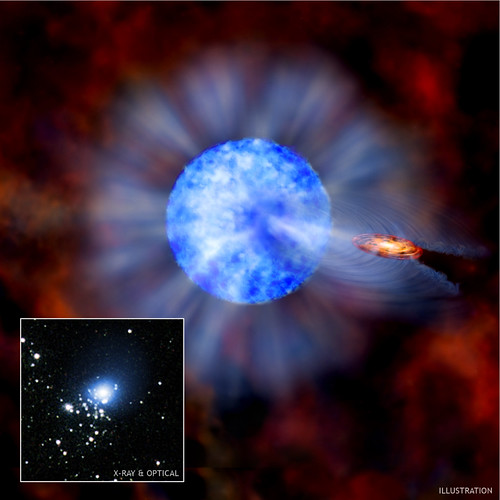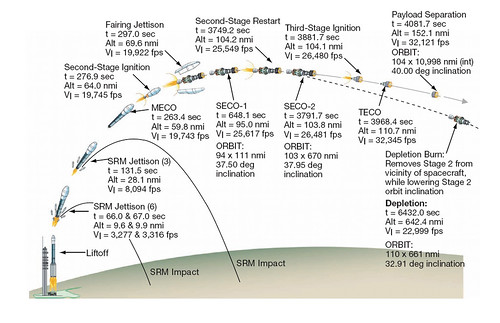I love the smell of hydrochloric acid in the morning! That’s what you get when you mix rocket fuel burn-off with the air around the launch pad.
A Delta II rocket will be the sight to see Wednesday morning at the Cape Canaveral Air Force Station (webcast). The details, courtesy of United Launch Alliance:
Rocket/Payload: Delta II launching the U.S. Air Force’s Global Positioning System (GPS) IIR-17M satellite.
Date/Launch Time/Site: Oct. 17, with a launch window of 8:23 – 8:38 a.m. EDT from Space Launch Complex-17A, Cape Canaveral Air Force Station, Fla. If the launch slips, the next launch attempt is set for Oct. 18, 8:19 – 8:34 a.m. EDT.
Description: GPS IIR-17 (M) will be the fourth modernized NAVSTAR Global Positioning System (GPS) military navigation satellite to launch. GPS is a space-based radio-positioning system consisting of a minimum of 24-satellite constellation that provides navigation and timing information to military and civilian users worldwide.
Launch Updates: To keep up to speed with updates to the launch countdown, dial the ULA launch hotline at 1-877-852-4321.
Satellite Feeds:
Test Signal Start Date/Time: 10/17/2007 07:45:00 EASTERN
Program Start Date/Time 10/17/2007 8:00:00 EASTERN
End Date/Time: 10/17/2007 10:00:00 EASTERN
Downlink: Galaxy 26
Transponder – G26C-09
ORBITAL POSITION: 93 DEGREES (W)
BAND-C ANALOG
BANDWIDTH 36 MHz
DOWNLINK FREQ 3880 MHz (V)
When Chris Bruce isn’t keeping his 19-year-old daughter’s car running, he’s using his considerable mechanical ability to lead the team of technicians preparing the third stage of Delta 2 rockets for launch.
The GPS IIR-17 launch from Complex 17A on Wednesday morning will be the latest of nearly 50 rockets on which the 45-year-old Mims resident has worked.
Weighing 4,540 pounds, the satellite will be the fourth to feature newer GPS technology. It will be able to provide more accurate navigation data for pilots, drivers, boaters, hikers and the military.
Working conditions are tough. The good-natured
ribbing between his colleagues at United Launch Alliance, who also are his golfing buddies, often rises to a level of nastiness that only the thick-skinned and steel-nerved can bear.
There is one consolation.
"What goes around comes around," he said, showing a good-natured grin. "What you’ve dished out the day before, you’re receiving the next day."
The constant needling and trading of verbal jabs keeps the crew on their toes, he added. Oddly, it also makes for a good work environment.
"We’re like a second family," he said. "It’s like hanging out with your brothers."
Long hours at work are required during crunch times, and Bruce’s boss depends on him to make sure people and parts are where they should be.
"He leads with his experience," said Robin Smith, an assembly and test manager with 37 years of aerospace experience. "And I do count on him and rely on him a lot."
Bruce’s easygoing personality makes him a good co-worker.
"He’s very good natured," Smith said.
Bruce is among about 4,000 United Launch Alliance employees who launch government satellites for the company formed by a merger of the rocket divisions of Lockheed Martin Corp. and The Boeing Co. in May 2005.
His crew assembles the launcher’s third stage, which is about six feet tall and will push the GPS satellite to its final orbit about 11,000 miles above Earth. The spacecraft will become one of 30 GPS satellites in orbit.
"We’ve been really good about putting them right where they need to be," Bruce said.
Bruce came to Brevard County 22 years ago, after completing a two-year associate’s degree in electronics at DeVry University in Atlanta.
"I had an uncle who worked for McDonnell Douglas. He got me an interview, and the rest is history," he said.
After several job changes, including working as a roofer for a year during a slowdown, Bruce started working on the Delta program in 1996.
If successful, this GPS launch would be the 77th Delta launch since the last failure in 1997. Consistency has been a hallmark of the program.
"There have been very few changes since I’ve been in this group," Bruce said. "It’s basic, but it’s efficient."
Bruce said the experienced crew is comfortable processing the rocket’s third stage because they have done the job many times before.
"It’s just like clockwork," he said. "Everything gets bolted and torqued. We’ve done it so much, we just know."
Bruce said attention to detail and the determination to do a good job are the personality traits that make his group successful.
"It was the way I was brought up," he said. "My dad always had the philosophy, ‘If you’re going to do it, do it right the first time. Put forth your best effort.’ "
"It’s the whole group. It has to be right," he said. "There’s no room for error."
During Wednesday’s launch, Bruce will follow the countdown even though he doesn’t work with the launch crew.
"I really don’t worry," he said. "I know the system is reliable and it always has been."






